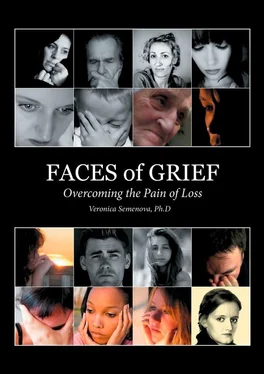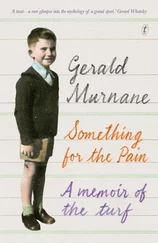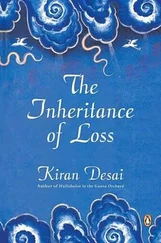Faces of Grief
Overcoming the Pain of Loss
Veronica Semenova
© Veronica Semenova, 2020
ISBN 978-5-0051-1800-4
Created with Ridero smart publishing system
Important Note
This book is not intended as a substitute for medical advice or treatment.
Any person with a condition requiring medical attention should consult a qualified medical professional or suitable therapist.
Veronica Semenova, Ph. D. is a private practicing psychologist working with a variety of psychological conditions, including depression, anxiety, grief, bereavement, coping with chronic and critical illness, fear of death, caregiver issues, aging issues, interpersonal and relationship issues. She is a member of the American Psychological Association, Psi Chi International Honor Society in Psychology, and the Association for Psychological Therapies.
Dr. Semenova is the author of «Learn How to Cope with Death, Loss, Grief, and Bereavement – Helpful Tips from the Cognitive-Behavioral Therapy».
Visit Dr. Semenova’s website at www.vsemenova.comfor more information.
Many books are written about grief: what it is and how to deal with it – but no loss is the same. The intensity of grief depends on many different factors. Grief varies between young and old and between cultures and religions, and depends on levels of existing dysfunction and on the nature of death (if the death was expected or sudden). It depends on previous experiences with death and attachment styles, and, of course, interpersonal factors play a very important role, as well. Grief also depends on the personality of the bereaved and the type of relationship the bereaved had with the deceased. Unprocessed emotions in that relationship, conflicts, repressed feelings, and unspoken words all come out in grief and weigh heavily upon a grieving person, often complicating recovery.
In Faces of Grief, I share many stories of grief from my psychotherapy practice and explain how grief can be anticipatory, disenfranchised, or complicated. I also discuss the common myths about grief. All stories reveal the extensive work that the bereaved has to go through to enable them to come to terms with guilt, self-reproach, and the pain of grief.
I also provide practical information on how to help yourself or your grieving loved one, how to talk to children about death and grief, and what not to say to a person who is grieving. This book will be useful for anyone going through bereavement and grief, and for those supporting them.
Chapter one. Losses in our Life
«The deep pain that is felt at the death of every friendly soul arises from the feeling that there is in every individual something which is inexpressible, peculiar to him alone, and is, therefore, absolutely and irretrievably lost.»
Arthur Schopenhauer (1788—1860)
There comes a time in everyone’s life when the death of a loved one – a spouse, parent, child, sibling, or a friend – enters the room. Some people experience it as kids when one of their elder relatives dies, while others do not experience loss until later on in life. In some tragic cases, early loss occurs when the parent of a young child passes away. Death is one sure thing, like birth, that happens to all living beings.
Many of us remember the first time the word death was spoken: when we found a dead insect, when a family pet died, or when an elderly relative passed away. These events generate acute curiosity. Children may observe people crying, parents mourning, or funeral arrangements being made. Parents often rush to comfort the child and offer a consoling explanation (“Don’t worry: Granddad is just in a deep sleep, and his soul is traveling to heaven.”). Different stories of eternal life, meeting again in heaven, being re-born or resurrected, and so on are shared with children. I imagine you’ve heard some of these explanations, too.
Later on, children find out that death has nothing to do with “deep sleep”. By then, anxiety and fear have conquered their minds. In fact, some children are afraid to sleep as a result of “death explanations”, and their parents may wonder why. If you were told that dying is like going to sleep, then it would be hard to sleep without worrying about dying.
I can’t repeat this enough to parents who need to explain a death in the family to their young child: Please do not hide the truth. Children are able to cope with the knowledge of death. At different ages, this understanding is different, but the truth is better than any of the stories commonly used as explanations.
In fact, there is often a relationship between sleep and death. Sleep and the loss of consciousness that takes place when we sleep is thought by many to be a “death rehearsal” that happens to us every night. (By the way, in Greek mythology, Thanatos (death) and Hypnos (sleep) are twin brothers.)
One way or another, the myths of dying are one day dismissed. That usually happens around adolescence, as young individuals realize their own and their loved ones’ mortality. The end of belief in fairy tales brings about the first existential crisis: the end of childhood and the beginning of adolescence, with the accompanying strong animosities that teenagers often display. The first loss leaves a very deep scar; and even if it happened very early on in life, the consequences of reactions to that loss (words that were exchanged by grown-ups at the time, or rituals observed) all define the ways in which future losses will be experienced and handled.
In the chapter “Grief in Children”, I will describe how children see and understand death at different developmental ages and why it is important to be honest and present information about death and loss in a way that is understandable to a child, which does not foster myths, fears, or anxiety.
No matter when the next loss happens and how close the relationship was with the person who passed away, grief is a natural reaction to loss. Nobody is ever prepared for grief. You can’t learn to deal with grief until the feeling overwhelms you, bringing with it sadness, anger at destiny, despair, and acute loneliness. Anger resolves over time – we learn to live with our loss, and there comes a time when it doesn’t hurt as much as it did – but why doesn’t the sadness go away? Why do we still hurt every time we come close to the next anniversary of our loved one’s birth or death, and why does flipping through pictures or letters bring so much heartache? If grief is a natural reaction to loss, then how long is it normal for that reaction to last?
I will answer these and many more questions in this book. In fact, there are so many myths surrounding grief – what’s normal and what’s not, how the bereaved should be “handled”, and what to say to a grieving person – that it would require a set of books just to go over all the myths and resolve many misconceptions. Whether the grieving person is you yourself or if you are reading this to find some helpful advice for someone close to you who is dealing with the loss of a loved one, I am sure this book will provide the necessary tools and support to help you through this difficult time.
Sadly, our society tends to impose rules on what is acceptable in grief and what’s not. How often do you hear that mourning a loss should not exceed one year? So, according to this logic, after precisely 365 days, a grieving person is expected to magically stop crying and feeling sad? It does not happen that way. Grief, even one year after a loss, may feel overwhelming and cause depression, loneliness, anxiety, and the feeling that the deceased is still present and continues to communicate.
Читать дальше












